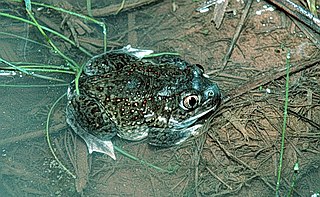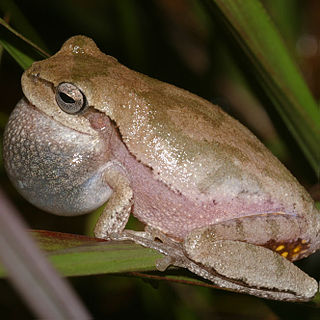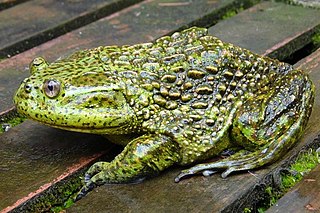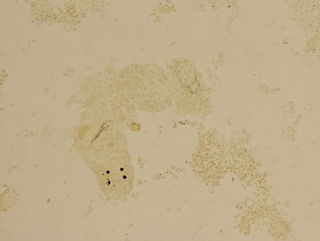
Amphibians are ectothermic, anamniotic, four-limbed vertebrate animals that constitute the class Amphibia. In its broadest sense, it is a paraphyletic group encompassing all tetrapods excluding the amniotes. All extant (living) amphibians belong to the monophyletic subclass Lissamphibia, with three living orders: Anura, Urodela (salamanders), and Gymnophiona (caecilians). Evolved to be mostly semiaquatic, amphibians have adapted to inhabit a wide variety of habitats, with most species living in freshwater, wetland or terrestrial ecosystems. Their life cycle typically starts out as aquatic larvae with gills known as tadpoles, but some species have developed behavioural adaptations to bypass this.

Metamorphosis is a biological process by which an animal physically develops including birth transformation or hatching, involving a conspicuous and relatively abrupt change in the animal's body structure through cell growth and differentiation. Some insects, jellyfish, fish, amphibians, mollusks, crustaceans, cnidarians, echinoderms, and tunicates undergo metamorphosis, which is often accompanied by a change of nutrition source or behavior. Animals can be divided into species that undergo complete metamorphosis ("holometaboly"), incomplete metamorphosis ("hemimetaboly"), or no metamorphosis ("ametaboly").

The flatworms, flat worms, Platyhelminthes, or platyhelminths are a phylum of relatively simple bilaterian, unsegmented, soft-bodied invertebrates. Being acoelomates, and having no specialised circulatory and respiratory organs, they are restricted to having flattened shapes that allow oxygen and nutrients to pass through their bodies by diffusion. The digestive cavity has only one opening for both ingestion and egestion ; as a result, the food can not be processed continuously.

A frog is any member of a diverse and largely carnivorous group of short-bodied, tailless amphibians composing the order Anura. The oldest fossil "proto-frog" Triadobatrachus is known from the Early Triassic of Madagascar, but molecular clock dating suggests their split from other amphibians may extend further back to the Permian, 265 million years ago. Frogs are widely distributed, ranging from the tropics to subarctic regions, but the greatest concentration of species diversity is in tropical rainforest. Frogs account for around 88% of extant amphibian species. They are also one of the five most diverse vertebrate orders. Warty frog species tend to be called toads, but the distinction between frogs and toads is informal, not from taxonomy or evolutionary history.

A tadpole is the larval stage in the biological life cycle of an amphibian. Most tadpoles are fully aquatic, though some species of amphibians have tadpoles that are terrestrial. Tadpoles have some fish-like features that may not be found in adult amphibians such as a lateral line, gills and swimming tails. As they undergo metamorphosis, they start to develop functional lungs for breathing air, and the diet of tadpoles changes drastically.

Trematoda is a class of flatworms known as flukes or trematodes. They are obligate internal parasites with a complex life cycle requiring at least two hosts. The intermediate host, in which asexual reproduction occurs, is usually a snail. The definitive host, where the flukes sexually reproduce, is a vertebrate. Infection by trematodes can cause disease in all five traditional vertebrate classes: mammals, birds, amphibians, reptiles, and fish.

Monogeneans, members of the class Monogenea, are a group of ectoparasitic flatworms commonly found on the skin, gills, or fins of fish. They have a direct lifecycle and do not require an intermediate host. Adults are hermaphrodites, meaning they have both male and female reproductive structures.

The goliath frog, otherwise known commonly as the giant slippery frog and the goliath bullfrog, is a species of frog in the family Conrauidae. The goliath frog is the largest living frog. Specimens can grow up to 32 centimetres (12.6 in) in length from snout to vent, and weigh up to 3.25 kilograms (7.2 lb). This species has a relatively small habitat range in Cameroon and Equatorial Guinea. Its numbers are dwindling due to habitat destruction, collection for food, and the pet trade.

The Aspidogastrea is a small group of flukes comprising about 80 species. It is a subclass of the trematoda, and sister group to the Digenea. Species range in length from approximately one millimeter to several centimeters. They are parasites of freshwater and marine molluscs and vertebrates. Maturation may occur in the mollusc or vertebrate host. None of the species has any economic importance, but the group is of very great interest to biologists because it has several characters which appear to be archaic.

The plains spadefoot toad is a species of American spadefoot toad which ranges from southwestern Canada, throughout the Great Plains of the western United States, and into northern Mexico. Like other species of spadefoot toads, they get their name from a spade-like projection on their hind legs which allows them to dig into sandy soils. Their name, in part, comes from their keratinized metatarsals, which are wide instead of "sickle shaped". The species name translates as buzzing leaf shaped. This refers to the species' distinguishing features; its buzzing mating call, and its leaf-shaped digging metatarsals. It was first described by Cope in 1863.

Atelopus glyphus, the Pirri harlequin frog or Pirri Range stubfoot toad, is a species of toad in the family Bufonidae found in Colombia and Panama within the Northwestern Andean montane forests. Its natural habitats are subtropical or tropical moist montane forests and rivers.

The pine woods tree frog is a species of frog in the family Hylidae, endemic to the southeastern United States.

Diplozoon paradoxum is a flatworm (platyhelminth) from the class Monogenea. It is found in freshwater fishes in Asia and Europe and known for its complete monogamy. This parasite is commonly found on the gills of European cyprinid fishes. It is usually around 0.7 centimeters long and has bilateral symmetry. It has several hooks at its mouth which it uses to grab on to the gills of a fish. From there it feeds on the blood of the cyprinid.
Ribeiroia ondatrae, or the frog-mutating flatworm is a parasite in the genus Ribeiroia which is believed to be responsible for many of the recent increases in amphibian limb malformations, particularly missing, malformed, and additional hind legs.

Spawn is the eggs and sperm released or deposited into water by aquatic animals. As a verb, to spawn refers to the process of freely releasing eggs and sperm into a body of water ; the physical act is known as spawning. The vast majority of aquatic and amphibious animals reproduce through spawning. These include the following groups:

Calyptocephalella is a genus of frogs in the family Calyptocephalellidae. It is represented by a single living species, Calyptocephalella gayi, commonly known as the helmeted water toad, Chilean helmeted bull frog, or wide-mouthed toad. Additionally, there are a few extinct species that are only known from Late Cretaceous and Paleogene fossil remains from Patagonia in South America and the Antarctic Peninsula. The helmeted water toad living today is aquatic to semi-aquatic, and found in deep ponds and reservoirs in central Chile and possibly adjacent west-central Argentina.

Dactylogyrus vastator is a species of monoic flatworms of class Monogenea. It is an ectoparasite of fish which infests the gills. It is problematic on fish farms. It is otherwise non-hazardous to humans.
Megalodiscus temperatus is a Digenean in the phylum Platyhelminthes. This parasite belongs to the Cladorchiidae family and is a common parasite located in the urinary bladder and rectum of frogs. The primary host is frogs and the intermediate hosts of Megalodiscus temeperatus are freshwater snails in the genus Helisoma.

Polyopisthocotylea is a subclass of parasitic flatworms in the class Monogenea.

Alaria is a genus of flatworms, or trematodes, in the family Diplostomidae.


















